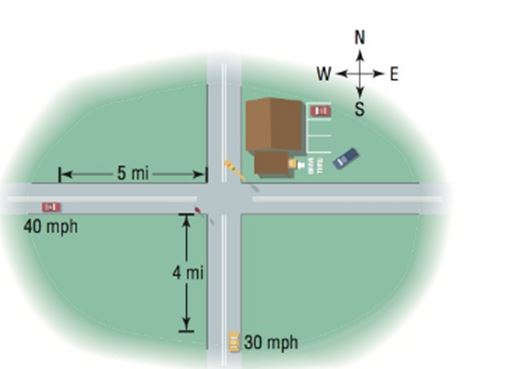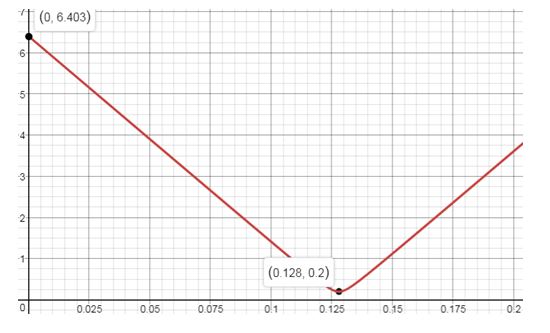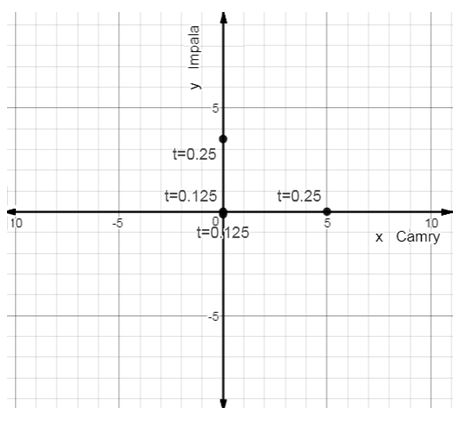
Concept explainers
To find:
a. Parametric equations that model the motion of the Camry and Impala.
Answer to Problem 57AYU
a. Camry: , ; Impala: ,
Explanation of Solution
Given:
A Toyota Camry (traveling east at 40 mph) and a Chevy Impala (traveling north at 30 mph) are heading toward the same intersection. The Camry is 5 miles from the intersection when the Impala is 4 miles from the intersection.

Calculation:
a. At ,
Camry is at a distance of 5 miles from intersection and is travelling east at a speed of 40mph.
Parametric equation for Camry:
,
At ,
Impala is 4 miles from the intersection and is travelling north at a speed of 30mph.
Parametric equation for Impala:
,
To find:
b. Formula for the distance between the cars as a function of time?
Answer to Problem 57AYU
b.
Explanation of Solution
Given:
A Toyota Camry (traveling east at 40 mph) and a Chevy Impala (traveling north at 30 mph) are heading toward the same intersection. The Camry is 5 miles from the intersection when the Impala is 4 miles from the intersection.

Calculation:
b. As per the given figure we can use Pythagoras theorem to find the distance in terms of
To find:
c. Graph the function in part c.
Answer to Problem 57AYU
c. graph is plotted
Explanation of Solution
Given:
A Toyota Camry (traveling east at 40 mph) and a Chevy Impala (traveling north at 30 mph) are heading toward the same intersection. The Camry is 5 miles from the intersection when the Impala is 4 miles from the intersection.

Calculation:
c. Graph the function in part c.

To find:
d. The minimum distance between the cars? When are they closest?
Answer to Problem 57AYU
d. distance between the cars is miles. At hours, the cars are closer to each other.
Explanation of Solution
Given:
A Toyota Camry (traveling east at 40 mph) and a Chevy Impala (traveling north at 30 mph) are heading toward the same intersection. The Camry is 5 miles from the intersection when the Impala is 4 miles from the intersection.

Calculation:
d. From the graph above the minimum distance between the cars is miles. At hours, the cars are closer to each other.
To find:
e. Simulate the motion of the cars by simultaneously graphing the equations found in part (a).
Answer to Problem 57AYU
e. Graph is plotted.
Explanation of Solution
Given:
A Toyota Camry (traveling east at 40 mph) and a Chevy Impala (traveling north at 30 mph) are heading toward the same intersection. The Camry is 5 miles from the intersection when the Impala is 4 miles from the intersection.

Calculation:
e. Graph of the equation found in a.

Chapter 10 Solutions
Precalculus
Additional Math Textbook Solutions
University Calculus: Early Transcendentals (4th Edition)
Elementary Statistics (13th Edition)
Basic Business Statistics, Student Value Edition
A Problem Solving Approach To Mathematics For Elementary School Teachers (13th Edition)
Elementary Statistics: Picturing the World (7th Edition)
A First Course in Probability (10th Edition)
- Solve by superposition method the following DE: y^(4) - y = xe^(x) sen(2x), conditions: y(0) = y'(0) = y''(0) = y'''(0) =0arrow_forwardUse the annulus method to find the solution of the DE: y''' + 8y = e^(3x) sen(3x) cos(3x)arrow_forward3:59 m s ☑ D'Aniello Boutique | Fashion VOLTE danielloboutique.it/asia SUBSCRIBE NOW: 10% OFF TO USE ANYTIME YOU WANT d'aniello NEW IN WOMEN NEW IN MEN WINTER SALE: 50% OFF on FW24 SHOP WOMEN SHOP MENarrow_forward
- JOB UPDATE EMERSON GRAD ENGINEER (FRESHERS) SOFTWARE ENGG NEW RELIC BROWSERSTACK (FRESHERS) SOFTWARE ENGG FULL STACK DATA ENGINEER GENPACT + PYTHON CARS24 WORK FROM HOME #vinkjobs TELE PERFORMANCE Vinkjobs.com CUSTOMER SUPPORT Search "Vinkjobs.com" on Googlearrow_forwarddo question 2 pleasearrow_forwardquestion 10 pleasearrow_forward
- 00 (a) Starting with the geometric series Σ X^, find the sum of the series n = 0 00 Σηχη - 1, |x| < 1. n = 1 (b) Find the sum of each of the following series. 00 Σnx", n = 1 |x| < 1 (ii) n = 1 sin (c) Find the sum of each of the following series. (i) 00 Σn(n-1)x^, |x| <1 n = 2 (ii) 00 n = 2 n² - n 4n (iii) M8 n = 1 շոarrow_forward(a) Use differentiation to find a power series representation for 1 f(x) = (4 + x)²* f(x) = 00 Σ n = 0 What is the radius of convergence, R? R = (b) Use part (a) to find a power series for f(x) = 1 (4 + x)³° f(x) = 00 Σ n = 0 What is the radius of convergence, R? R = (c) Use part (b) to find a power series for f(x) = x² (4 + x)³* 00 f(x) = Σ n = 2 What is the radius of convergence, R? R = Need Help? Read It Watch It SUBMIT ANSWERarrow_forwardanswer for question 4 pleasearrow_forward
- (3) (20 points) Let F(x, y, z) = (y, z, x²z). Define E = {(x, y, z) | x² + y² ≤ z ≤ 1, x ≤ 0}. (a) (2 points) Calculate the divergence V. F. (b) (4 points) Let D = {(x, y) | x² + y² ≤ 1, x ≤ 0} Without calculation, show that the triple integral √ (V · F) dV = √ 2²(1. = x²(1 − x² - y²) dA. Earrow_forward(2) (22 points) Let F(x, y, z) = (x sin y, cos y, ―xy). (a) (2 points) Calculate V. F. (b) (6 points) Given a vector field is everywhere defined with V G₁(x, y, z) = * G2(x, y, z) = − G3(x, y, z) = 0. 0 0 F(x, y, z) = (F₁(x, y, z), F₂(x, y, z), F(x, y, z)) that F = 0, let G = (G1, G2, G3) where F₂(x, y, y, t) dt - √ F³(x, t, 0) dt, * F1(x, y, t) dt, t) dt - √ F Calculate G for the vector field F(x, y, z) = (x sin y, cos y, -xy).arrow_forwardEvaluate the following integral over the Region R. (Answer accurate to 2 decimal places). √ √(x + y) A R R = {(x, y) | 25 < x² + y² ≤ 36, x < 0} Hint: The integral and Region is defined in rectangular coordinates.arrow_forward
 Calculus: Early TranscendentalsCalculusISBN:9781285741550Author:James StewartPublisher:Cengage Learning
Calculus: Early TranscendentalsCalculusISBN:9781285741550Author:James StewartPublisher:Cengage Learning Thomas' Calculus (14th Edition)CalculusISBN:9780134438986Author:Joel R. Hass, Christopher E. Heil, Maurice D. WeirPublisher:PEARSON
Thomas' Calculus (14th Edition)CalculusISBN:9780134438986Author:Joel R. Hass, Christopher E. Heil, Maurice D. WeirPublisher:PEARSON Calculus: Early Transcendentals (3rd Edition)CalculusISBN:9780134763644Author:William L. Briggs, Lyle Cochran, Bernard Gillett, Eric SchulzPublisher:PEARSON
Calculus: Early Transcendentals (3rd Edition)CalculusISBN:9780134763644Author:William L. Briggs, Lyle Cochran, Bernard Gillett, Eric SchulzPublisher:PEARSON Calculus: Early TranscendentalsCalculusISBN:9781319050740Author:Jon Rogawski, Colin Adams, Robert FranzosaPublisher:W. H. Freeman
Calculus: Early TranscendentalsCalculusISBN:9781319050740Author:Jon Rogawski, Colin Adams, Robert FranzosaPublisher:W. H. Freeman
 Calculus: Early Transcendental FunctionsCalculusISBN:9781337552516Author:Ron Larson, Bruce H. EdwardsPublisher:Cengage Learning
Calculus: Early Transcendental FunctionsCalculusISBN:9781337552516Author:Ron Larson, Bruce H. EdwardsPublisher:Cengage Learning





